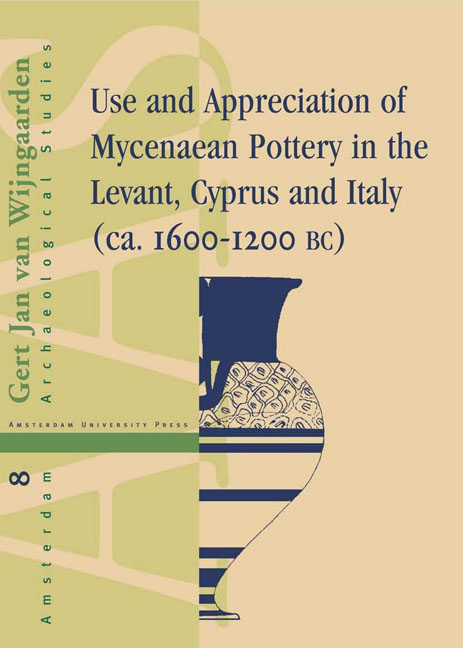4 - Mycenaean Pottery in the Levant: Introduction
Published online by Cambridge University Press: 10 February 2021
Summary
PREVIOUS RESEARCH
The Syro-Palestinian littoral, commonly known as the Levant, is now taken up by six modern nation states: Turkey, Syria, Lebanon, Israel, Jordan and the Palestine Autonomy. This configuration and the political instability in the region over the last fifty years have influenced archaeological research, and any interpretation of distribution patterns in this area is hazardous. This is true also for the distribution of Mycenaean pottery, which has been found at 111 sites, from Charchemish (site no. 133) in Turkey to Tell es-Shari’a (site no. 243) in northern Sinai (Map 6). The concentration of sites visible in the southern Levant is at least partly caused by the intensity of archaeological research since the foundation of Israel in 1948. Moreover, for a long time research has been difficult at many sites in Lebanon, which has influenced the quality of the information available.
The earliest report, to my knowledge, of Mycenaean pottery in the Levant is given by F.J. Bliss in 1894 who had discovered it at El-Hesy (site no. 231) in Palestine. F.B. Welch named Tell es-Safiyeh (site no. 228) as another site with Mycenaean imports and saw an Aegean influence in Levantine vase shapes and decoration. R.C. Bosanquet probably referred to these publications when he asserted the presence of Mycenaean pottery in southern Palestine. None of these scholars distinguished between actual Mycenaean pottery and so-called Philistine ware, a distinction that was first made by H. Thiersch in 1908.
In the early decades of the twentieth century, several sites with Mycenaean pottery were excavated in southern Palestine, among them Garife (site no. 159), Gezer (site no. 224) and `Ain Shems (site no 227). As a result, D. Fimmen in 1924 was able to list six sites. The discovery of a tomb near Minet el-Beida (site no. 142) in Syria in 1928 and the subsequent excavations by C.F.A. Schaeffer at the site and at nearby Ras Shamra (site no. 141) can be considered a landmark in the research of Mycenaean pottery in the Levant. Not only did these discoveries establish the presence of Mycenaean pottery in the northern Levant, the amounts of that pottery on both sites at the time exceeded that on any other.
- Type
- Chapter
- Information
- Use and Appreciation of Mycenaean Potteryin the Levant, Cyprus and Italy (1600-120O BC), pp. 31 - 36Publisher: Amsterdam University PressPrint publication year: 2002



